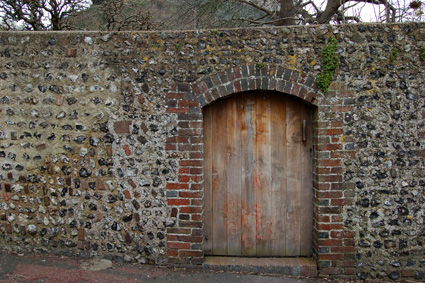
Doorway along Castle Lane
Lewes doesn't make the tourist map, at least for Americans. It's a good-sized town, with plenty to fill a day or two, but we went there just to get out of London, to go someplace that we knew we could go for proper tea and a relaxing walk. I'd learned of Lewes from Melissa, when we were both in Brighton, because it was just a short distance away but worlds apart. And you could sit down for tea and scones before making a visit to the local brewery and shop.
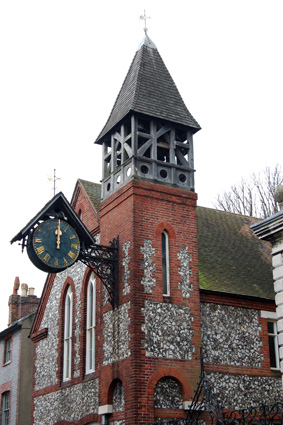
Tower and clock along High Street
It feels like a proper old English town, though I'm not entirely sure what that really is. But, if I had to hazard a guess, Lewes would be it. Settled in the Sussex hills, along the little River Ouse, the little, winding streets of Lewes are downright charming. Of course, since we went on a Saturday, a good number of other Britons had the same idea, but overcast skies and chilly winds kept the streets reasonably empty. By the time the afternoon soccer games had started, there wasn't a soul to be seen.
There are a handful of old buildings throughout town, and not much that looks terribly recent. It lends a distinct character, quite English, to the buildings, the streets, and everything. Even on the High Street, where giant plate glass retail windows are the norm, you find gems like the tower and clock above. Then, just a short stroll further along, you come across the Fifteenth Century Bookshop.
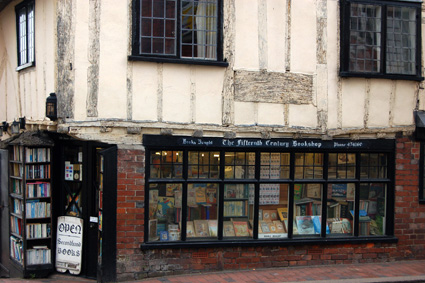
Fifteenth Century Bookshop
It's so called because the building's been standing since then. Now it's a bookstore specializing in secondhand books and children's literature, with books of all sorts piled and stacked in every available space, as one would expect. When I visited there years ago, the exterior was covered in scaffolding for facade repairs, so this was the first opportunity I'd had to see it all exposed. Though seeing masonry structures several centuries old isn't uncommon throughout Europe, an exposed timber frame is a little less ordinary.
Just inside the door is a list of all of the previous occupants of the building, as best can be determined. The list goes back hundreds of years, with only a few gaps, though a used bookstore, a business trading in history and imagination, really seems like the most appropriate tenant possible.
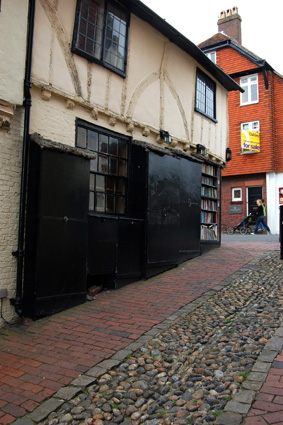
Fifteenth Century Bookshop
Older than the bookshop is Lewes Castle, perched atop a steep hill just about across the street. It's not much more than a small keep with an uninviting climb up for any would-be invaders, but you could certainly expect the best view in town from up there. Then again, the worm's-eye view of some of the imposing structures around the castle aren't too shabby, either, especially the imposing Barbican Gate:
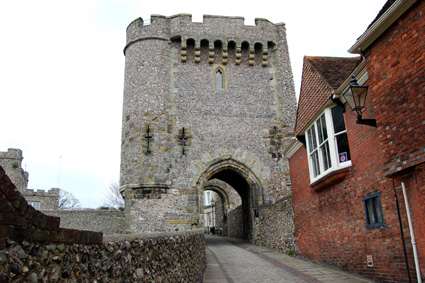
Barbican Gate
It's big, impressive, and a fascinating piece of history in an out-of-the-way sort of town. But it was also decidedly brisk outside, and we were more than happy to go someplace warm for a change. The primary reason for visiting Lewes was that we knew where we could find a good little shop for tea, and so that's where we went.
Robson's of Lewes is on the High Street as you approach the river, where the hill becomes steep enough that you're glad you're not driving. Or parallel parking. When we left for Lewes, I couldn't remember the name, but I knew I'd recognize it as soon as I saw it. Just a little shopfront along the street, it widens back into the building, and has a second seating area just a floor below, which is where I've always ended up. Upstairs, it seems, is always full when I arrive.
There's a general cafe menu of soups and sandwiches, and they seem to do a thriving lunch business - especially since things were just as busy as I remember from nearly seven years ago. We weren't there for the usual lunch, though. We went for tea.
Or half tea, really. The full tea includes finger sandwiches and all that. A half tea, as the menu calls it, consists of a pot of tea and two warm scones with butter, clotted cream and raspberry jam. There's enough of a coffeehouse atmosphere that you can linger a while, soaking in the warmth, before venturing back outside. One of my favorite things is that, by ordering a pot of tea, there's no need to specifically ask for no milk. Milky tea, as near as I can tell, is just the British way of rescuing tea that's been overextracted.2 Which is fine, if that's your thing, but I do wish folks wouldn't add it without asking.
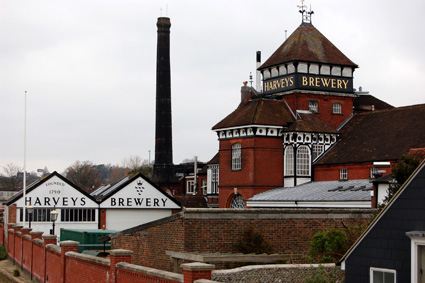
Harveys Brewery
From there, we decided to amble over to Harveys Brewery. You can't tour the brewery - at least, not without a prior appointment, which we certainly didn't have - but you can look through the brewery shop, which is endlessly fascinating. In addition to their many, many fine beers, ranging from bitters to pale ales to holiday brews, you can pick up a range of wines from around Britain and the world. Granted, the international selection's nothing to get overly excited about, but the fruit wines - many produced nearby in West Sussex - are fascinating.
I don't know if they're any good, of course, but the possibilities include: Parsnip Wine; Rose Petal Wine; Silver Birch Wine; Rhubarb Wine; and my personal favorite, because I don't know what to make of it, Black Beer & Raisin Wine. I have no idea what it is, but I'd buy a bottle if I saw it around here.
Leaving the brewery, crossing the Lewes Bridge, the air was rich with the smell of wort, dark malts and fresh hops.
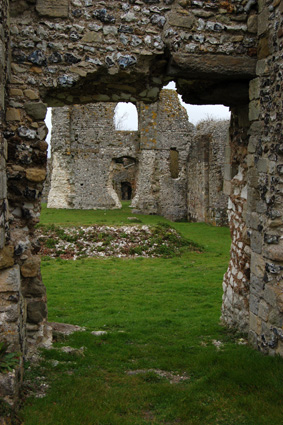
Ruins of the Priory of St. Pancras
With time to kill, we consulted our handy visitor map, which listed the various sights of interest around Lewes. There's the Anne of Cleves House, built for the ex-wife of Henry VIII to provide her with an income; Lewes Castle and Harveys Brewery, which we'd already been by; and a little mark west of the Sussex Downs College playing fields noted "Lewes Priory (Remains)". That would be the Priory of St. Pancras, or the ruins thereof. The sign notes that informational brochures are available at the Tourist Information Centre, and there's a brief history noted, but it's essentially a collection of crumbling stone walls.
Photogenic ones, too, especially if you get up close enough to poke the camera lens through the fence.
By this point, we were back in the mode where the needs for food, warmth and restrooms were coming back to life, so we decided to find a decent place to eat, all the better to stave off our eventual return to London. Pubs are usually a safe bet, if you're willing to accept that fact that food quality can range anywhere from edible-but-unthrilling to top-notch-homestyle-comfort-food. But not all pubs serve food, and some only at limited hours. So it's best to approach with an open mind. I try to use beer quality as a barometer of food quality, but I'm not sure how foolproof that really is.
Given that, we stopped into The Brewery Arms, on High Street, in part because they were serving some Harveys brews, and because there was a menu outside that looked good enough. Despite being almost nestled among the shops, it appeared to be a low-key place for locals, and we relaxed at a corner table as a group of mostly old men argued about a variety of different nothings. I had a pint of Harveys Old Ale, which was rather like a traditional bitter with dark malts - medium bodied, lightly carbonated, with a noticeable but relaxed hop presence. Sharon enjoyed a half pint of Biddenden Kentish Cider, which was dry and quite delicious, and surprisingly alcoholic at 8.0%.
Dinner was straightforward pub food, which reminded me of something I'd long forgotten: though the British may have invented the sandwich, they don't really seem to get the hang of it. When they offer a pork sausage sandwich, it'll consist of pork sausages and bread. (Best to at least ask for some mustard or mayo.) And, somehow, most places still don't know how to properly cook french fries.3 Still, dinner was pretty good: the sausages weren't overcooked, like I've come to expect; Sharon's tomato soup was really good; and the onion rings were excellent and not at all greasy.
I was also cheered to see that the beer mats were from Harveys, highlighting its local, sustainable efforts. The front side is an sketch of the traditional barley and hops harvest. The back notes that Harveys sources its raw materials from local growers, and that it restricts its deliveries to a fifty mile radius, ensuring that the beers are tailored to the local palate. It's what I like to see.
Now, for one more photograph, just because I like it:
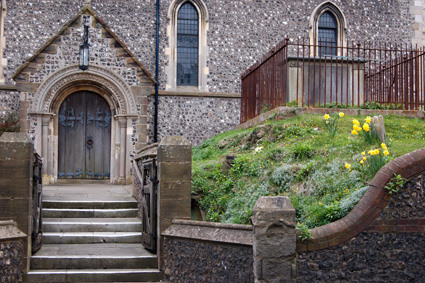
St. Anne's Church
* * * * *
1They would also have a restroom, which ends up being ever on one's mind when traveling. So you buy coffee or tea so you can use the facilities, and it just builds into a vicious cycle.
2It is funny, though, that the back of herbal teabag packets in Britain specifically state to drink without milk.
3Double-fry 'em, like the Belgians do with their frites. One time to cook the potato through, and a second time, at a higher temperature, to get the outside all crispy-crunchy. And, please, don't overcrowd the fryer. It drops the oil temperature so nothings crisps, and they all end up sticking together, anyhow.

No comments:
Post a Comment